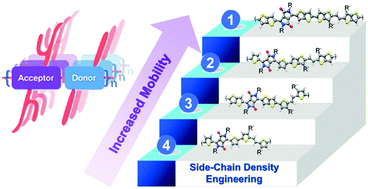Highly-soluble multi-alkylated polymer semiconductors and applications in high-performance field-effect transistors†
Abstract
High-mobility semiconducting polymers feature tightly packed microstructures that enable efficient charge transport networks. However, this aggregation typically leads to limited solubility, which compromises their processability. It remains underdeveloped to balance the carrier mobility and solution-processability. In this work, a multi-alkylation strategy is used to resolve the dilema, simultaneously allowing ease of processing and efficient charge transport. For homologuous polymer backbones, tuning of the side-chain density changes the self-assembly motif at the molecular level, leading to enhanced charge transport behaviors with a maximum hole mobility of up to 6 cm2 V−1 s−1. This is among the highest values for polymer-based field-effect transistors on poly(ethylene terephthalate) substrates to date. The aggregation control was characterized by grazing-incidence X-ray diffraction, near-edge X-ray absorption fine structure, and Raman spectroscopy, and the results were further validated by theoretical simulations showing the significant effect of the side-chain density on the stacking of polymer aggregates. These systematical results enrich the library of highly soluble, high-performance polymer semiconductors and provide a new perspective for promoting the applicability of semiconductors for industrial processing.



 Please wait while we load your content...
Please wait while we load your content...